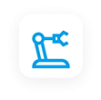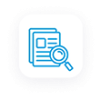The world is facing increasingly critical challenges in producing food and agricultural products. This is due to the rise in population, growing affluence, and several ecological factors. In order to overcome these challenges, scientists and engineers are attempting to integrate new technologies such as Artificial Intelligence, IoT, and robotics into farming.
Deploying advanced agricultural techniques and robotic automation can help us increase agricultural production and meet the world’s rising food demands. While these robots ensure consistency and reliability in farming processes, they can also help make sustainable agricultural management decisions.
Agriculture robots can also help address the shortfall in the agricultural workforce in developed countries. Here are five agriculture robots you can expect to see in the future.
5 Robots Shaping the Future of Agriculture
1. Husky UGV
Husky is a medium-sized automated unmanned ground robot that can be customized to perform research or agricultural operations in harsh environments. Due to its high payload capacity, the UGV can be used for multiple agricultural purposes, including pulling mowers and carts, cotton harvesting, weeding, and conducting operations in steep slope vineyards and olive groves.
Husky’s all-terrain tires and powerful motors allow it to conquer any terrain. It uses multiple sensors and systems for accurate positioning and navigation, including 3D LiDAR, GNSS receiver, IMU’s and stereo cameras. In addition, Husky is compatible with a wide range of robotic accessories and offers support in ROS.
2. Ecorobotix AVO
The Ecorobotix AVO weeding robot is an agriculture robot powered by the sun. It is a sustainable and fully autonomous robot that can cover 323K square feet of land in a single day and perform weeding operations on both plane lands and row crops. A four-wheel drive, visual navigation system, and lightweight GPS sensors help the robot navigate through obstacles.
The weeding robot also uses a complex set of cameras to target and spray weeds, while its ability to make precise detections reduces herbicide use by over 90%. In addition, AVO employs machine learning techniques to select and spray weeds with a microdose of herbicides.
3. Mamut
Mamut is an AI-powered autonomous robotic platform designed to explore fields and capture data on yield and crop health at an individual level. The robot consists of LiDAR sensors, an inertial measurement unit (IMU), wheel odometers, stereo cameras, and a compass, while an onboard AI system helps make sense of multiple sensor data inputs.
Mamut gives growers the ability to derive accurate and actionable information on their crops on an everyday basis. Granular data from the canopy will enable farmers to predict and optimize yields for more output with minimal input. The robot also has the ability to learn from unknown routes in real-time due to its simultaneous localization and mapping capabilities (SLAM).
4. Precision Hawk
The Precision Hawk UAV uses remote sensing technologies to complete multiple farming operations like mapping, crop dusting, crop scouting, and spraying from the sky. It employs advanced data analytics techniques to improve everyday operations and decision-making. The aerial drone uses multiple sensors, including thermal, LiDAR, multispectral, and hyperspectral sensors.
Drones can consistently monitor crops and livestock to find problems that are not visible from ground level. For example, one could detect inconsistencies in irrigation by studying sensor inputs in a timelapse format. With drones like Precision Hawk, farmers can perform precision agriculture (PA) by ensuring the efficiency of inputs such as water and fertilizers to improve productivity, quality, and yield.
5. SwagBot
SwagBot is a four-wheeled mechanical cowboy that is capable of safely navigating cattle, inspecting plants, or removing weeds on a farm. Attributing to its structure and LiDAR plus RGB object detection system, the robot can easily make its way through rough terrains and conquer logs, swamps, or free falls without toppling over.
At the moment, this robot has the ability to automate pasture surveys, animal monitoring, and weed control. However, with better integrations, SwagBot can be applied for several other agricultural processes, such as monitoring cattle health by analyzing temperature and gait and determining where to find grass.
Quality Sensors for Optimized Automated Farming
The food gap is potentially one of the greatest threats to humanity in the future. This is why we must strive toward devising more accurate and resourceful farming methodologies. The power of robotic automation and high-accuracy sensors can help us expend minimal resources and achieve the best outcomes.
At Hokuyo, we offer a full range of sensor technologies for automation processes. From OEMs and R&D firms to resellers and end-users, we offer highly accurate sensors for autonomous robotics applications across North America.
Our products include laser rangefinders (LIDAR), obstacle detection sensors, optical data transmission devices, and collision avoidance sensors.
Take a look at some of our popular sensor products or reach out to us and learn more about how Hokuyo can help you build the next agricultural robot.

 Factory Automation
Factory Automation Logistics Automation
Logistics Automation Process Automation
Process Automation Crane Collision Avoidance
Crane Collision Avoidance LiDAR/Obstacle Detection
LiDAR/Obstacle Detection Safety Laser Scanners
Safety Laser Scanners Optical Data Transmission
Optical Data Transmission Hot Metal Detectors
Hot Metal Detectors Laser Distance Sensor
Laser Distance Sensor Blog
Blog Whitepapers
Whitepapers Case Studies
Case Studies Infographics
Infographics